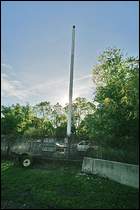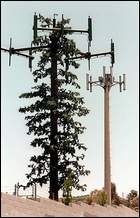|
10/27/2005
Cell Towers: Striking a balance
Cell users want reception, but not towers
Note to providers: Disguising tower as giant cross doesn't help
By ANGIE BASIOUNY
The News Journal
10/27/2005
Everybody wants a cell phone. Nobody wants a tower.
All those conversations -- from the business executive closing a deal while in line at Starbucks to teenagers trying to find each other at the mall -- require communications equipment high above the landscape to relay signals. That usually means a steel tower soaring over rooftops, trees and anything else that might interfere with transmission.
And that creates a buzz of its own. A growing number of conversations are among neighbors who are talking, organizing, planning and protesting wireless companies that are trying to place poles in residential areas to compete for better coverage and fewer dropped calls.
It's a predicament of the digital age: How do local governments protect citizens who don't want towers in their back yards while serving the interests of companies that need the structures to provide reliable service?
The short answer is, they can't.
A company with a license for wireless service is bound by federal law to provide quality coverage under the Federal Telecommunications Act of 1996. When local jurisdictions try to deny tower permits, companies cite the federal mandate when they file a lawsuit. And they often win.
Towers and the law
Industry advocates and land-use officials say the solution lies in compromise. Companies and citizens must work together to find workable sites while lessening the impact on neighborhood aesthetics.
The latest trend has companies disguising towers as trees, flagpoles, cactuses and windmills that blend better into the landscape. Kent County Levy Court approved a tower in September for a site in Felton, but required that it be disguised as a tree.
"It's not just about homeowners who don't want this ugly eyesore or about the companies who need to make money," New Castle County Councilman Robert Weiner said. "It's about all citizens who need to communicate."
Weiner drafted the county's first cell tower ordinance in 1996, after his first successful council campaign featured a hot debate over a tower near I-95 and Talley Road in Brandywine Hundred. Residents were upset that there was no opportunity for public input before it was built.
The law Weiner drafted, which is part of the county's land-use regulations, is fairly broad. Freestanding monopoles are permitted in any zoning district, but towers in residential districts need a special-use permit after a public hearing.
The law does give residents some leverage: A special-use permit can be denied if the board finds that a tower doesn't fit in with the character of the area.
Weiner said the law he drafted nearly a decade ago isn't perfect, but it was a start.
"I put together a study group of people in the industry and civic leaders, people who didn't even want to talk to each other, and we came up with a compromise," Weiner said. "It's striking a balance."
Councilman David Tackett is working on a revision to the law now that the county is doing a required five-year review of its comprehensive land-use plan. He wants higher standards for documenting that a tower is needed at a proposed location, and wants to force firms to present options for disguising towers.
"If it walks like a duck and quacks like a duck, at least it doesn't have to look like a duck," he said. "Landowners have rights and you can't just take them away. We want to come to a happy medium."
Shift to suburbs
The need for wireless service is following the population into the suburbs and rural areas, where monstrous towers don't blend in as well.
A longtime land-use attorney, Lisa Goodman has represented a number of wireless companies since the 1990s. She said they all share similar issues with co-location, coverage and upset residents.
"There are so many sites up in the air now that the noncontroversial sites have all been done," Goodman said. "My hope is that there is a change in technology that will permit lower towers, but I don't know of that happening."

The News Journal/ROBERT CRAIG |
On Philadelphia Pike in Claymont, a flagpole does double duty as a cell tower. |

Los Angeles Times/DAVID BOHRER |
In Los Angeles, a cell tower disguised as a pine tree stands next to a bare one. Many companies are now using camouflage techniques to try to head off uproar from neighbors. |
BY THE NUMBERS
197 million U.S. wireless customers
66% Households with wireless service
6% to 10% Wireless-only households
178,025 Cell equipment sites
32.5 billion Text messages, first six months of 2005
Source: CTIA-The Wireless Association
New Castle County code
Rules for communications towers
• They can be built in any zoning district, but need a special-use permit in residential areas.
• They must be set back from adjoining property by at least one-third the height of the tower.
• They must allow for co-location -- the addition of at least one other company's equipment on the tower.
• No signs are permitted on the tower.
• Any tower not operated for six months is considered abandoned. If not removed in 90 days, the county may remove it at the owner's expense.
Contact Angie Basiouny at 324-2796 or abasiouny@delawareonline.com.
Back to the News Summary
Have news? Please contact me! |
Give Bob a "like" on Facebook:
|



 Subscribe to RSS feed
Subscribe to RSS feed